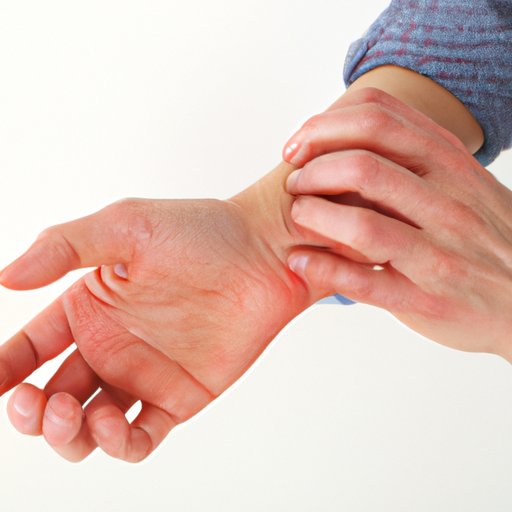
I. Introduction
Arthritis is a common condition that affects millions of people worldwide. It is caused by inflammation and pain in the joints, leading to stiffness, reduced range of motion, and other symptoms. You may be at risk of developing arthritis, but do not worry, as there are ways to prevent and treat it. This article will guide you on how to recognize arthritis, its symptoms, causes, diagnosis methods, prevention measures and the options available for treatment.
II. Symptoms to Look Out For
Arthritis symptoms can range from mild to severe and vary depending on the type of arthritis. Some common signs to look for include joint pain, stiffness or swelling, limited range of motion, weakness, and fatigue. If you experience these symptoms for more than a week, it is best to consult a doctor.
The symptoms may also show up differently for various types of arthritis. For instance, Osteoarthritis typically affects the joints that bear weight, such as the hips, knees, and spine. On the other hand, Rheumatoid arthritis often affects the hands, wrists, and knees.
III. Diagnosis Methods
There are several approaches to diagnosing Arthritis:
- Imaging Tests: These tests include X-rays, CT scans, and MRI scans. They show the shape and condition of the bones and cartilage.
- Blood Tests: These tests analyze your blood for inflammation markers, antibodies, and other indicators of any type of arthritis
- Physical examination: Your doctor will examine the affected joints for swelling, redness, and limited range of motion.
- Joint aspiration: Also known as arthrocentesis, this process involves the removal of fluid from an affected joint using a needle and analyzing it for infection, uric acid, and crystals.
Your doctor may also ask you questions about your medical history, carry out a joint count, and recommend more specialized tests such as bone density tests and ultrasounds.
IV. Risk Factors and Causes
Arthritis risk factors and causes may differ from person to person. Some factors that may increase the likelihood of developing arthritis include:
- Age: As you get older, the risk of developing arthritis increases
- Genetics: Arthritis may run in families; people with a family history of arthritis are more susceptible
- Obesity: Carrying excess weight adds extra stress to joints, increasing the risk of arthritis.
- Injury: Injuries to joints, particularly those that are repetitive, can increase the risk of developing arthritis
- Infections: Some infections such as Lyme disease and hepatitis B increase the likelihood of arthritis
Therefore, staying active, maintaining a healthy weight, reducing joint stress, and having your injuries treated by a medical professional can reduce your risk of developing arthritis.
V. Preventative Measures
There are preventive measures you can adopt to reduce the risk of developing arthritis. These include:
- Maintaining a Healthy Weight: Losing weight reduces the pressure on your joints, reducing the risk of developing arthritis
- Exercising Regularly: Physical activities like walking, swimming, and cycling help prevent arthritis by keeping the bones and cartilage strong.
- Reducing Joint Stress: This means avoiding unnecessary motions and stresses on your joints.
- Protecting Your Joints: Always wear protective gear when doing activities that pose a risk of joint injury.
- Balanced Eating habits: Consuming foods rich in anti-inflammatory properties like Omega-3 fats can prevent joint complications.
Preventive measures could be an effective way of reducing the risk of developing arthritis. However, it is essential to maintain a balance of these activities so as not to strain your joints.
VI. Treatment Options
If you are already experiencing arthritis symptoms, several medical procedures and lifestyle changes can be adopted to manage them. Here are some of them:
- Medications: Pain relievers, disease-modifying antirheumatic drugs (DMARDs), and corticosteroids are some of the medications that your doctor may prescribe to relieve the symptoms of arthritis
- Physical Therapy: Exercises like swimming, stretching and cycling under the guidance of a trained therapist could help in relieving some of the pains and improving mobility of the affected joints.
- Surgery: This may be a consideration for severe cases of arthritis when the joint damage cannot be repaired using any other methods. Examples include joint replacement, fusion and resurfacing techniques.
- Alternative Therapies: These are non-medical approaches to the management of arthritis, such as acupuncture, meditation, and massage
VII. Conclusion
Arthritis is a painful condition that can lead to reduced mobility. However, recognizing the symptoms, diagnoses, and effective management can greatly reduce the risk of developing arthritis and may also improve its symptoms. Maintaining a healthy weight, reducing joint stress, and exercising regularly are some of the preventative measures to reduce the risk of developing arthritis. Medical procedures, lifestyle changes, and alternative therapies also exist that improve arthritis symptoms. By following these effective preventive and treatment measures, you can lead a comfortable and active life.




